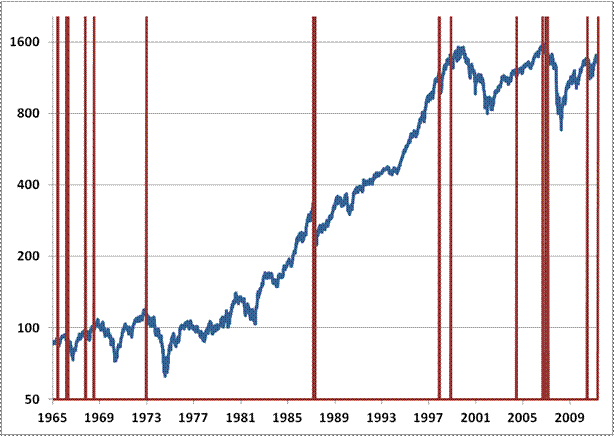Hussman Funds Investors Opt for Safety Within Risky Investments
Post on: 13 Июль, 2015 No Comment

Investors Opt for Safety Within Risky Investments
William Hester, CFA
February 2005
All rights reserved and actively enforced.
One topic that’s likely to be under the microscope this year is whether risky assets are appropriately priced. The Federal Reserve recently weighed in on the subject. Policy meeting minutes released last month showed that some Fed members are concerned that the prolonged period of low rates may be leading to excessive risk-taking in the financial markets. They referenced narrow credit spreads, an increase in initial public offerings, and possible speculation in housing markets.
So investors may be reconsidering what to pay for risky assets. Most benchmarks that track smaller companies and new issues are down for the year, even though larger companies are roughly flat. But a profitable habit is tough to break. During the post-election rally, and during all of 2003, “low quality” was generously rewarded. Generally, the smaller the company and the shakier its financial health, the better it did. That might help explain why investors – though not avoiding risky assets altogether – seem to be turning more selective.
Take small caps. The two most popular indexes for tracking this group are the Russell 2000 (RTY) and the S&P 600 (SML). The performance of these indices has diverged this year. The SML reached an all-time high this week, before backing off at the end of the week. Since the beginning of the year the index is roughly flat, while the Russell has dropped by more than 3 percent. That spread between returns may not seem large, but the ratio of the two shows that the recent relative performance is noteworthy.
The SML’s better showing this year is not surprising in a longer-term context. The SML has been quietly outperforming the RTY for over a decade. Since 1989, the S&P 600 has gained about 1.5 percent a year more than the Russell 2000, and has achieved a better return in 11 of the last 15 years.
But over shorter periods, they switch leads. In 2003, when risk was in vogue, the Russell index easily beat Standard & Poor’s benchmark, rising 45 percent to SML’s 37 percent. Part of this can be explained by the construction of each index. Russell’s benchmark is based purely on market capitalizations. It consists of the bottom two-thirds of the 3,000 companies with the largest market caps. What the RTY has in numbers it lacks in size. The 2,000 stocks in the index make up just 9 percent of the value of the Russell 3000.
The SML is built much like S&P’s benchmark of bigger companies. A committee chooses candidates based on market value, earnings history, and additional liquidity and stock price requirements. Most companies are required to have four consecutive quarters of reported earnings (the GAAP kind). Because of these restraints, SML’s holdings tend to be larger and less speculative than RTY’s, on average. So far this year, investors seem to be favoring higher quality, even among small cap stocks.
Other Risky Classes

Other risky investments are showing a similar pattern. IPO performance has traced a similar path as the small-stock benchmarks over the past two years. Rallying in 2003, dropping in the first half of 2004, while finishing the year strong.
But the same discretion for quality within a risky group can be seen in the new issue market, too. The Bloomberg IPO index, which consists of all stocks that have had an initial public offering in the last year, has fallen by 3 percent since the beginning of the year. The IPOX-30, an index of only the largest IPO’s, has gained .7 percent during that period. Once again, investors aren’t shunning risk all together, just becoming more selective.
Similar trends can be seen in the bond market. The spread between high-yield bonds and U.S. Treasuries has widened, while the spreads on the debt of companies rated just a notch or two above speculative grade have been stable, or have even narrowed. The KDP High Yield Daily Index tracks 100 bonds that are both current and defaulted. This makes it one of the broadest proxies for the high yield market. That index traded at 215 basis points over the ten-year Treasury in early January. The spread rose by 55 basis points in the first three weeks of the year. The spread has since contracted some, but remains above its early January level. Meanwhile, intermediate-grade corporate bonds tracked by Barron’s began the year yielding 207 basis points above the 10-year Treasury. Last week the spread had narrowed to 183 basis points.
Beta and Bear Markets
GMO’s Investment Strategist Jeremy Grantham has noted that high beta stocks underperform the market during bear markets (suffering a peak to trough real return of –9 percent). When this group is richly valued – as it is now – high beta stocks underperform the market by an incredible 28.5 percent.
Indeed, divergent performance in high and low beta stocks is already evident this year. Looking at the 900 companies in S&P’s mid and large-cap indexes, the top quarter of stocks with the highest betas are down 4.28 percent. Low beta stocks are up 3.5 percent. This widening relative performance within the risky segments of the equity market could prove to be an important warning for investors, especially if the market were to turn down.














